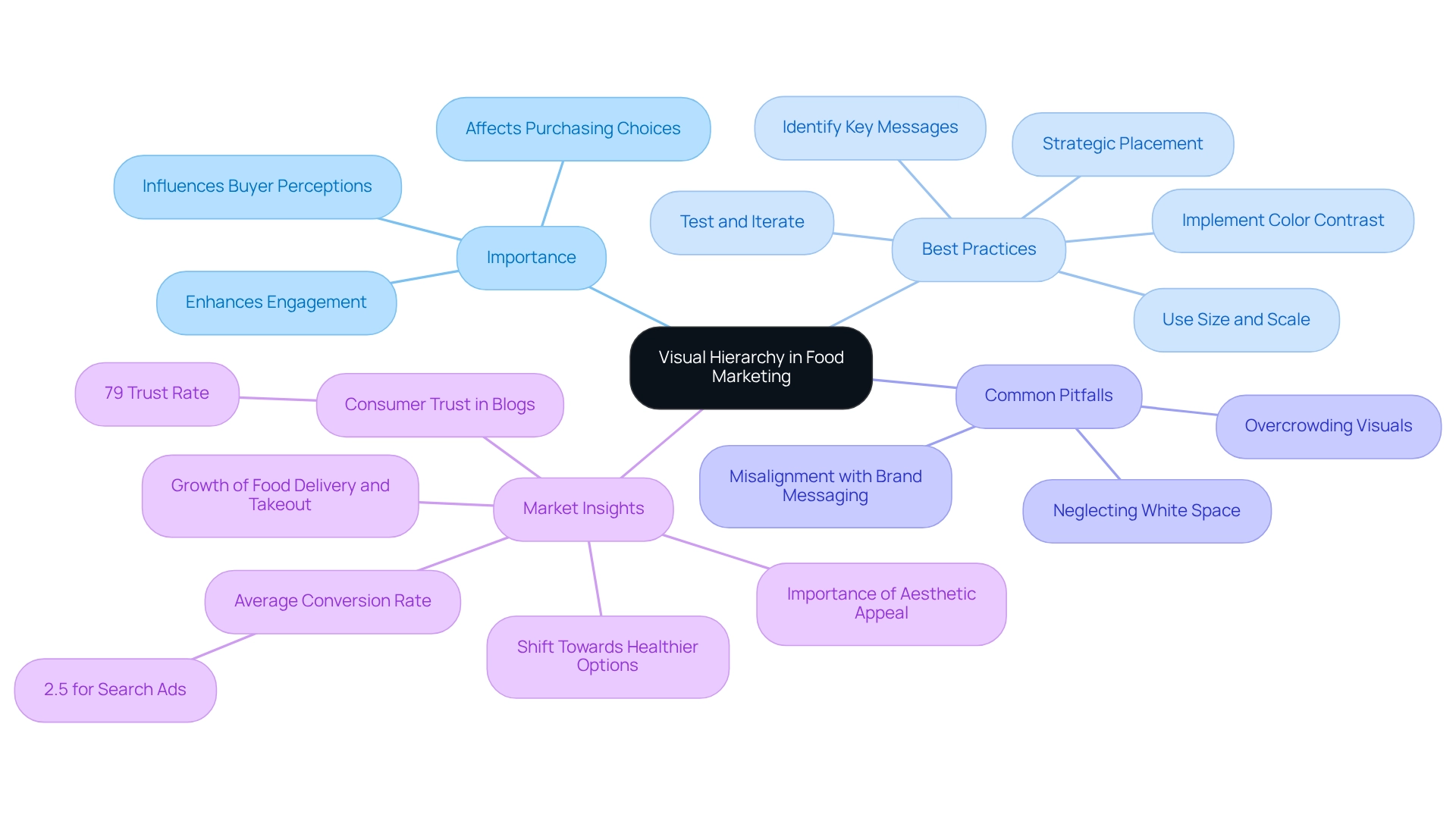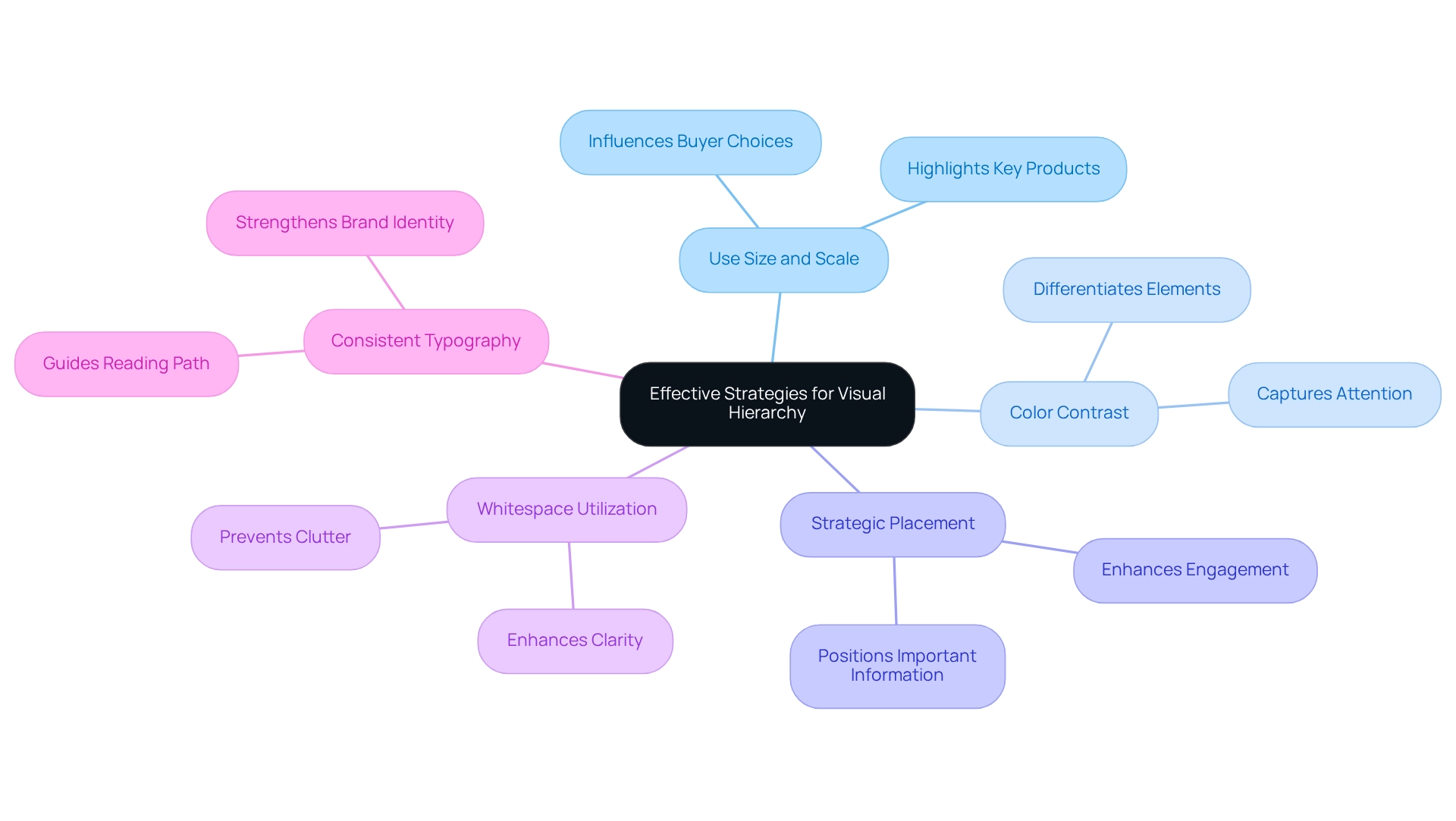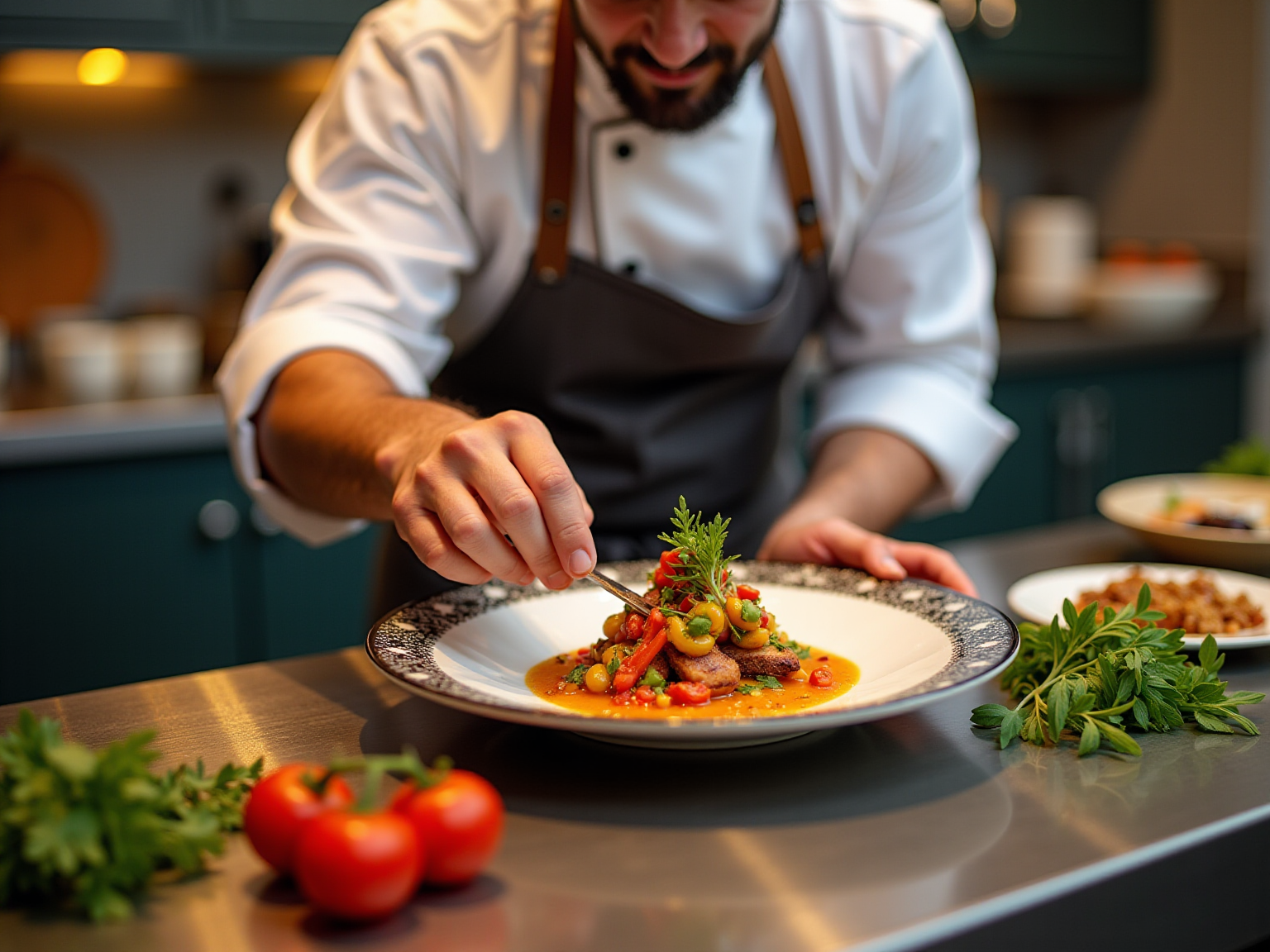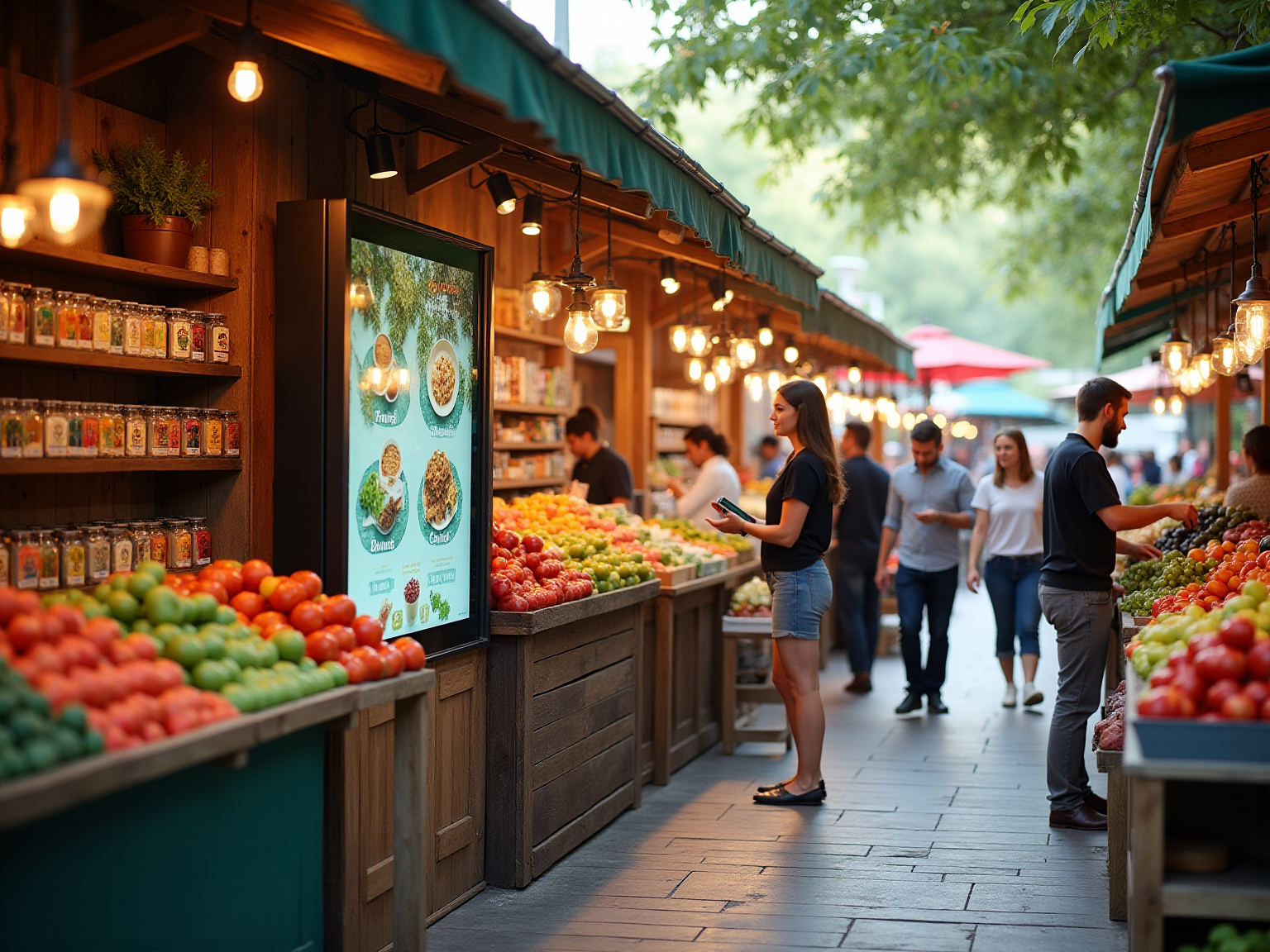Digital Branding Strategies
Best Practices for Visual Hierarchy in UAE Food Marketing
Overview
Best practices for visual hierarchy in UAE food marketing necessitate the strategic arrangement of design elements—size, color, and placement—to effectively influence consumer perceptions and purchasing decisions. By mastering these principles and incorporating cultural context, marketers can create visually appealing content that not only enhances engagement but also boosts sales in a competitive market. This knowledge empowers Brand Managers to navigate the complexities of consumer behavior, ensuring that their marketing strategies resonate deeply with the target audience.
Introduction
In the competitive realm of food marketing, the art of visual hierarchy stands as a crucial tool for capturing consumer attention and driving purchasing decisions. By strategically arranging design elements such as size, color, and placement, marketers can craft compelling visuals that convey essential messages and resonate with the target audience.
As consumer preferences shift—particularly towards healthier and culturally relevant options—understanding how to effectively implement visual hierarchy becomes paramount. This article delves into the principles and strategies that can elevate food marketing efforts, ensuring brands not only stand out in a crowded marketplace but also foster deeper connections with consumers.
Understand Visual Hierarchy in Food Marketing
Understanding the best practices for visual hierarchy in UAE food marketing is essential, as visual hierarchy is the strategic arrangement of design elements to convey their importance, playing a pivotal role in culinary marketing. This arrangement affects buyer perceptions and purchasing choices through key elements such as size, color, contrast, and placement. For instance, larger images of dishes naturally attract attention, while contrasting colors can effectively emphasize special offers or important messages. By mastering these principles, marketers can create engaging imagery that effectively directs buyer behavior.
To effectively apply hierarchy in food promotion, consider the following steps:
- Identify Key Messages: Determine what messages or offers are most important to convey.
- Use Size and Scale: Utilize larger images for key products to draw attention.
- Implement Color Contrast: Choose colors that stand out against the background to highlight important information.
- Strategic Placement: Position key elements where consumers are most likely to look first, such as the top left corner of an advertisement.
- Test and Iterate: Use A/B testing to see which designs resonate best with your audience.
Common pitfalls to avoid include overcrowding visuals with too much information, neglecting the importance of white space, and failing to align visuals with brand messaging. Recent research reveals that 73% of shoppers believe a product’s aesthetic appeal significantly impacts their purchasing choices. This highlights the need for brands in the UAE’s vibrant culinary industry to adopt best practices for visual hierarchy in UAE food marketing to stand out in the competitive environment. As buyer preferences change, especially towards healthier and sustainable choices, the significance of attractive packaging and promotional strategies becomes even more evident.
Insights from recent discussions in the industry emphasize that focusing on aesthetic appeal in product advertising can improve recognition and acceptance, aligning with market trends. Moreover, the typical conversion rate for search advertisements in the culinary and drink sector is 2.5%, highlighting how aesthetic attractiveness translates into quantifiable results in promotion. As the trend towards meal delivery and takeout persists, grasping the best practices for visual hierarchy in UAE food marketing is essential for brands seeking to attract attention and boost sales.

Implement Effective Strategies for Visual Hierarchy
To implement the best practices for visual hierarchy in UAE food marketing, consider the following strategies:
- Use Size and Scale: Larger elements naturally draw more attention, making them ideal for highlighting key products or promotions. This approach can significantly affect buyer choices, especially in a competitive market.
- Color Contrast: Employ contrasting colors to differentiate between various elements. For instance, a bright red sale tag against a neutral background can effectively capture attention and drive urgency.
- Strategic Placement: Position important information at the top or center of your design, where viewers are most likely to look first. This ensures that critical messages are seen immediately, enhancing engagement.
- Whitespace Utilization: Adequate spacing around elements enhances clarity and focus, preventing the design from feeling cluttered. This practice is particularly effective in the UAE’s vibrant market, where overwhelming imagery can detract from key messages.
- Consistent Typography: Use a hierarchy of font sizes and styles to guide the viewer’s reading path, emphasizing headlines and key messages. This not only assists in readability but also strengthens brand identity, as the best practices for visual hierarchy in UAE food marketing can be customized to suit the unique cultural environment, ensuring that the hierarchy of elements connects with local consumers.
As eating habits change, especially among Millennials who increasingly pursue food-related content on platforms like YouTube, utilizing effective design hierarchy in digital marketing becomes essential. Furthermore, the increasing popularity of QR code menus emphasizes the significance of clear graphical communication in improving customer experience and increasing restaurant sales. Projections indicate a significant increase in sales for restaurants adopting these technologies. Additionally, as highlighted by Helpscout, restaurants that actively reply to customer reviews on social media experience a 15% rise in customer satisfaction, emphasizing the significance of interacting with customers through effective communication.

Incorporate Cultural Context in Visual Design
Incorporating cultural context into visual design is crucial for effective culinary marketing in the UAE. To achieve this, Brand Managers should consider the following best practices:
- Cultural Symbols and Colors: Leverage colors and symbols that resonate with local traditions and values. For instance, green is often associated with freshness and health, making it an ideal choice for food products.
- Imagery Representation: Employ images that reflect the local culture and lifestyle. Highlighting traditional dishes or local ingredients can create a stronger bond with customers, enhancing relatability.
- Language Considerations: Ensure that any text used in visuals is culturally appropriate and, when necessary, available in both Arabic and English to cater to the UAE’s diverse population.
- Respect for Traditions: Be mindful of cultural sensitivities, particularly during significant periods like Ramadan, where marketing messages should be respectful and considerate of local customs.
- Common Pitfalls: Avoid stereotypes or misrepresentations of cultural symbols, as these can alienate consumers rather than engage them. Conduct thorough research to ensure authenticity in representation.
Aligning visual elements with cultural expectations not only fosters deeper connections with the audience but also enhances brand engagement and loyalty. Notably, brands that have effectively incorporated cultural context into their promotional strategies, such as Castania, utilized local imagery and traditional elements in their brand identity enhancement project, resulting in better market recognition and customer engagement. Furthermore, statistics from a recent PPC campaign in Dubai demonstrate that culturally relevant design can yield significant results, evidenced by a 35% increase in test drive bookings through augmented reality. As Alan D. Wolfelt aptly stated, “Food is symbolic of love when words are inadequate,” highlighting the emotional connection that culturally resonant promotion can create. By implementing the best practices for visual hierarchy in UAE food marketing, Brand Managers can effectively improve their promotional strategies.

Evaluate the Impact of Visual Hierarchy on Consumer Engagement
To effectively assess the influence of graphical hierarchy on consumer engagement, marketers must focus on several key metrics:
-
Engagement Rates: It is essential to track likes, shares, and comments on social media posts to evaluate how well visuals resonate with the audience. Engaging visuals can significantly enhance interaction; studies indicate that meme campaigns achieve a click-through rate 14% higher than traditional email marketing, particularly appealing to younger demographics. Given that 48% of Snapchat users are aged 15-25, targeting this demographic through effective imagery strategies is crucial.
-
Conversion Rates: Examine how changes in structural hierarchy impact sales or lead generation. Implementing A/B testing with various designs provides valuable insights into which strategies yield the best outcomes.
-
Client Input: Collect qualitative information through surveys or focus groups to gain a deeper understanding of user perceptions regarding design elements. This feedback is instrumental in guiding future design choices.
-
Heatmaps and Analytics: Utilize tools like heatmaps to monitor user interactions, revealing which elements capture the most attention and how users navigate through graphical content.
-
Audio-Visual Engagement: As highlighted by Basis Technologies, 53% of individuals who own a smart speaker and have heard an ad on their device indicate they are likely to respond to it. This underscores the significance of captivating imagery in audio-visual promotional strategies, particularly in culinary promotion.
By consistently assessing these elements, brands can enhance their imagery strategies, ensuring they effectively captivate consumers and inspire intended actions. Regular analysis of content performance is crucial for optimizing marketing strategies and applying best practices for visual hierarchy in UAE food marketing to enhance overall effectiveness. The digital landscape is evolving, with platforms like TikTok projected to generate $33.1 billion in advertising revenue by 2025, emphasizing the necessity for brands to adapt their visual content strategies to remain competitive.

Conclusion
The principles of visual hierarchy are essential in food marketing, empowering brands to capture consumer attention and drive purchasing decisions with precision. By strategically employing size, color, contrast, and placement, marketers can craft compelling visuals that effectively convey vital messages and resonate with their target audience. Key strategies, such as identifying core messages, leveraging color contrast, and ensuring strategic placement, are indispensable for creating designs that stand out in a competitive marketplace.
Moreover, incorporating cultural context into visual design is crucial, particularly in diverse markets like the UAE. By honoring local traditions, utilizing culturally relevant imagery, and ensuring language accessibility, brands can cultivate deeper connections with consumers. This cultural alignment not only enhances brand loyalty but also amplifies the effectiveness of marketing efforts, as demonstrated in successful case studies.
Finally, assessing the impact of visual hierarchy on consumer engagement is paramount. Marketers should concentrate on metrics such as engagement rates, conversion rates, and customer feedback to continuously refine their strategies. As the digital landscape evolves, adapting visual content to align with changing consumer preferences will be critical for brands striving to excel in the food marketing sector. Embracing these principles not only fosters meaningful connections with consumers but also drives measurable outcomes in sales and brand recognition.
Frequently Asked Questions
What is visual hierarchy in food marketing?
Visual hierarchy is the strategic arrangement of design elements to convey their importance, significantly impacting buyer perceptions and purchasing choices in culinary marketing.
How does visual hierarchy affect buyer behavior?
It affects buyer behavior through key elements such as size, color, contrast, and placement, helping to create engaging imagery that directs consumer attention effectively.
What are some key steps to apply visual hierarchy in food promotion?
Key steps include identifying key messages, using size and scale for important products, implementing color contrast, strategically placing elements, and testing designs through A/B testing.
What common mistakes should be avoided when applying visual hierarchy?
Common pitfalls include overcrowding visuals with too much information, neglecting white space, and failing to align visuals with brand messaging.
Why is aesthetic appeal important in food marketing?
Aesthetic appeal significantly impacts purchasing choices, with 73% of shoppers believing it influences their decisions, making it crucial for brands in the competitive UAE culinary industry.
What recent trends are influencing food marketing in the UAE?
Trends include a shift towards healthier and sustainable choices, increased focus on attractive packaging, and the growing popularity of meal delivery and takeout services.
What is the typical conversion rate for search advertisements in the culinary sector?
The typical conversion rate for search advertisements in the culinary and drink sector is 2.5%, indicating that aesthetic attractiveness can lead to quantifiable results in promotion.



